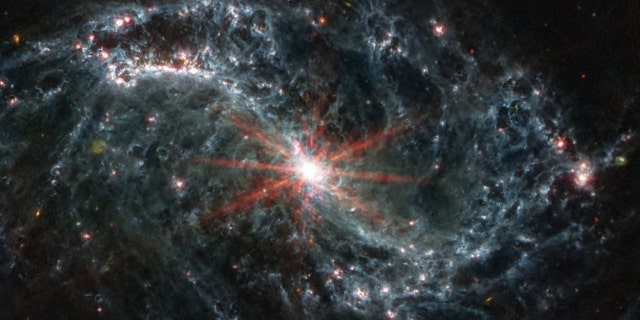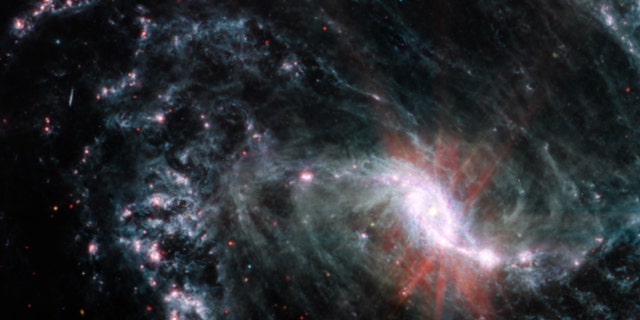Webb Space Telescope spies nearby galaxies with ‘unprecedented’ resolution

The James Webb Space Telescope has captured images of three nearby galaxies with unprecedented resolution at infrared wavelengths, giving them a first look at star formation, gas and dust.
Data has enabled researchers to pen 21 research papers, providing new insight into how the beginnings of star formation impact the evolution of galaxies. The data is part of an ongoing Webb survey of 19 spiral galaxies and observations of five of those targets have taken place.
The targets include the galaxies shown in the photos, including NGC 1365, NGC 7496 and NGC 1433.
The images from Webb’s Mid-Infrared Instrument, or MIRI, reveal the presence of highly-structure features, including glowing cavities of dust and huge cavernous bubbles of gas that line the spiral arms. In some regions, the features appear to be built from both individual and overlapping shells and bubbles where young stars are releasing energy.
NASA’S WEBB TELESCOPE CAPTURES NEVER-BEFORE-SEEN DETAILS IN PANDORA’S CLUSTER

New imagery from NASA’s James Webb Space Telescope is giving scientists their first look at high resolution into the fine structure of nearby galaxies and how that’s impacted by the formation of young stars. NGC 1433 is a barred spiral galaxy with a particularly bright core surrounded by double star forming rings. For the first time, in Webb’s infrared images, scientists can see cavernous bubbles of gas where forming stars have released energy into their surrounding environment. (Credits: NASA, ESA, CSA, and J. Lee (NOIRLab). Image processing: A. Pagan (STScI))
Webb’s high-resolution imaging can pierce through the dust, NASA notes, with wavelengths observable by MIRI and Webb’s Near-Infrared Camera (NIRCam) sensitive to emissions from polycyclic aromatic hydrocarbons – which play a critical role in the formation of stars and planets.
The molecules were detected by Webb in the first observations by the Physics at High Angular resolution in Nearby Galaxies (PHANGS) collaboration, which is conducting the largest survey of nearby galaxies in Webb’s first year of science operations.

The spiral arms of NGC 7496 are filled with cavernous bubbles and shells overlapping one another in this image from MIRI. These filaments and hollow cavities are evidence of young stars releasing energy and, in some cases, blowing out the gas and dust of the interstellar medium surrounding them. (Credits: NASA, ESA, CSA, and J. Lee (NOIRLab). Image processing: A. Pagan (STScI))
NEIL DEGRASSE TYSON SAYS JAMES WEBB SPACE TELESCOPE IS WINDOW TO UNIVERSE ‘NEVER BEFORE ACHIEVED’
The team of more than 100 researchers from around the globe will work to create and release data sets that align Webb’s findings to that obtained previously from other observatories.

In the MIRI observations of NGC 1365, clumps of dust and gas in the interstellar medium have absorbed the light from forming stars and emitted it back out in the infrared, lighting up an intricate network of cavernous bubbles and filamentary shells influenced by young stars releasing energy into the galaxy’s spiral arms. (Credits: NASA, ESA, CSA, and J. Lee (NOIRLab). Image processing: A. Pagan (STScI))
CLICK HERE TO GET THE FOX NEWS APP
“Thanks to the telescope’s resolution, for the first time we can conduct a complete census of star formation, and take inventories of the interstellar medium bubble structures in nearby galaxies beyond the Local Group,” Janice Lee, Gemini Observatory chief scientist at NOIRLab and University of Arizona affiliate astronomer, said in a statement. “That census will help us understand how star formation and its feedback imprint themselves on the interstellar medium, then give rise to the next generation of stars, or how it actually impedes the next generation of stars from being formed.”
Share this news on your Fb,Twitter and Whatsapp
Times News Network:Latest News Headlines
Times News Network||Health||New York||USA News||Technology||World News